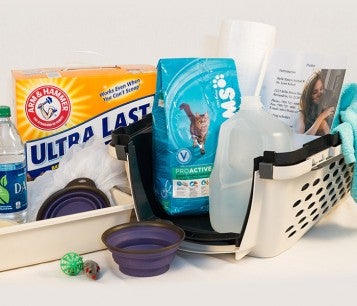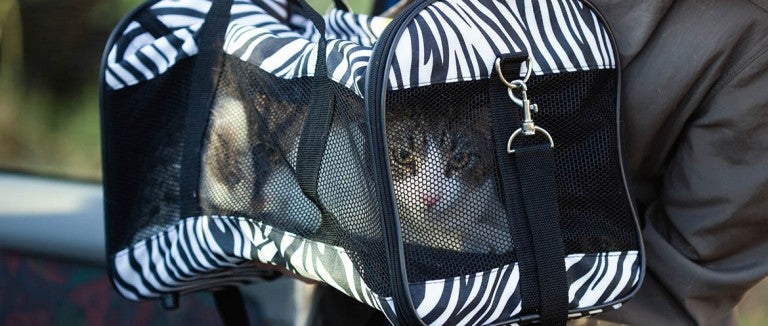When making travel decisions, choose what is safest and most comfortable for your pet. For instance, unless you'll be able to spend a lot of time with your dog, they'll probably be happier at home than tagging along on your trip. As a rule, cats are almost always better off in their own home. But if you have decided it's best to bring your pet along, follow our tips for a safe and low-stress trip!
By car
Do you know the best place for your dog or cat in your car?
Dogs shouldn't roam in the car
The safest way for your dog to travel in the car is in a crate that has been anchored to the vehicle using a seat belt or other secure means. Dog restraints or seat belts are useful for preventing your dog from roaming around the car and being a distraction to the driver, but they haven't been reliably shown to protect dogs during a crash.
Cats belong in carriers
Most cats aren't comfortable traveling in cars, so for their safety as well as yours, keep them in a carrier. It's important to restrain these carriers in the car so that they don't bounce around and hurt your cat. Do this by securing a seat belt around the front of the carrier.
Leave the front seat for humans
Keep your pet in the back seat of the car. If an airbag deploys while your pet is in the passenger seat (even in a crate), it might injure your pet.
Keep those heads inside
Dogs and cats should always be kept safely inside the car. Pets who are allowed to stick their heads out the window of moving vehicles can be injured by particles of debris or made sick by having cold air forced into their lungs. Never transport a pet in the back of an open pickup truck.
Give your pet plenty of rest stops
Stop frequently to allow your pet to exercise and eliminate, but never permit your pet to leave the car without a collar, ID tag and leash.
Bring along a human buddy
Whenever possible, share the driving and pet caretaking duties with a friend or family member. You'll be able to get food or use the facilities at rest stops knowing that someone you trust is keeping a close eye on your pets.
Don't ever leave your pet alone in a car
A quick pit stop may feel like no time at all to you, but it's too long to leave your pet alone in a car. Heat is a serious hazard: when it's 72 degrees Fahrenheit outside, the temperature inside your car can heat up to 116 degrees within an hour. On an 85-degree day, even with the windows slightly open, the temperature inside your car can reach 102 degrees in just 10 minutes. Even if you’re certain of your timing, you can get held up — in just 30 minutes, you could return to a 120 degree car and a pet suffering irreversible organ damage or death.
If you see a pet left inside a hot car, take these steps to help them.
Spread the word about the dangers of leaving pets in a hot car by printing our Hot Car flyer [PDF], posting it in public places and sharing it with your friends, family and coworkers.
Another hazard of leaving your pet in the car alone is the possibility of someone stealing your pet while you are away from the vehicle.
Use our checklist to assemble an emergency kit for yourself and all your pets. During disasters, creating an emergency plan can be a lifesaver.

By airplane
Before booking a flight for your pup, you’ll want to think through all your options.
Air travel can be risky for pets
We recommend that you weigh all the risks when deciding whether to transport your pet by airplane. Air travel can be particularly dangerous for animals with "pushed in" faces (the medical term is "brachycephalic"), such as bulldogs, pugs and Persian cats. Their short nasal passages leave them especially vulnerable to oxygen deprivation and heat stroke.
Consider all the alternatives to flying
If you plan to bring your pet on vacation, driving is usually a better option. If you can't travel by car, your pet will probably be healthier and happier if you leave them behind under the care of a pet-sitter or boarding kennel. But there are times when that won’t be possible and you’ll have to determine whether the benefits of flying outweigh the risks.
Visit your vet
Most airlines require a health certificate for animals, typically issued within 10 days of travel. This is also a good time to ensure your pet’s vaccinations are up to date and that they aren’t battling any illnesses that could be exacerbated by heat or stress.
Research your destination
If you’re flying internationally, or even to Hawai'i, your pets may need to be quarantined upon arrival. They may also require import forms. Familiarize yourself with the requirements, where they’ll be quarantined and for how long.
If you decide to fly with your pet, choose the cabin when possible
If transporting your pet by air is the only option, find out whether they can travel in the cabin with you. Most airlines will allow you to take a cat or small dog in the cabin for an additional fee. But you must call the airline well in advance; there are limits to the number of animals allowed in the cabin. If you are transporting your dog, make sure they meet the size requirements. If you get overwhelmed by all the regulations, there are companies that can help you navigate through the process of flying with a pet.
Ask these questions if your pet is flying in the cabin
When you contact the airline, be sure to get clear answers to these questions:
- Will the airline allow you to take your cat or small dog in the cabin with you?
- Does the airline have any special pet health and immunization requirements?
- Does the airline require a specific type of carrier? Most airlines will accept either hard-sided carriers or soft-sided carriers (which may be more comfortable for your pet), but only certain brands of soft-sided carriers are acceptable to certain airlines.
- If you can't take your pet in the cabin, does the airline have any restrictions on transporting your pet in the cargo hold?
Take precautions when bringing your pet through airport security
Your pet's carrier will have to pass through the security screening along with you. You have two options: Either be sure your pet is securely harnessed so you can safely contain them outside their carrier while it's being x-rayed, or request a special secondary screening that won't require you to take them out of their carrier.
Be aware of the dangers of flying your pet in a cargo hold
While most animals flown in the cargo area of airplanes are fine, you should be aware that some animals are killed, injured or lost on commercial flights each year. Excessively hot or cold temperatures, poor ventilation and rough handling are often to blame.
Most U.S. airlines are required to report all companion animal incidents that occur in the cargo hold, and consumers should study the performance record of any airline before choosing to fly your pet in a cargo hold.
Follow these tips if your pet must fly in the cargo hold
If your pet must travel in the cargo hold, you can increase the chances of a safe flight for your pet by following these tips.
- Use direct flights. You will avoid the mistakes that occur during airline transfers and possible delays in getting your pet off the plane.
- Travel on the same flight as your pet when possible. Ask the airline if you can watch your pet being loaded into the cargo hold and unloaded.
- When you board the plane, notify the captain and at least one flight attendant that your pet is traveling in the cargo hold. If the captain knows that pets are on board, they may take special precautions.
- Don't ever ship brachycephalic animals such as Pekingese dogs, bulldogs or Persian cats in the cargo holds.
- If traveling during the summer or winter months, choose flights that will accommodate the temperature extremes. Early morning or late evening flights are better in the summer; afternoon flights are better in the winter.
- Fit your pet with a collar that can't get caught in carrier doors. Affix two pieces of identification on the collar: a permanent ID with your name and home address and telephone number, and a temporary travel ID with the address and telephone number where you or a contact person can be reached. Make sure your pet’s microchip information is up to date.
- Affix a travel label to the carrier on which you've written your name, permanent address and telephone number, final destination and where you or a contact person can be reached as soon as the flight arrives.
- Make sure that your pet's nails have been clipped to protect against them getting hooked in the carrier's door, holes and other crevices.
- Give your pet at least a month before your flight to become familiar with the travel carrier. This will minimize their stress during travel.
- Do not give your pet tranquilizers unless they are prescribed by your veterinarian. Make sure your veterinarian understands that the prescription is for air travel.
- Do not feed your pet for four to six hours before the trip. However, you can give them small amounts of water. If possible, put ice cubes in the water tray attached to the inside of your pet's crate or kennel. (A full water bowl will only spill and cause discomfort.)
- Try not to fly with your pet during busy travel times such as holidays and the summer. Your pet is more likely to undergo rough handling during hectic travel periods.
- Carry a current photograph of your pet. If your pet is lost during the trip, a photograph will make it much easier for airline employees to search effectively.
- When you arrive at your destination, open the carrier as soon as you are in a safe place and examine your pet. If anything seems wrong, take your pet to a veterinarian immediately. Get the results of the examination in writing, including the date and time.
Speak up if you see something
Don't hesitate to complain if you witness the mishandling of an animal—either yours or someone else's—at any airport. Ask to speak with the manager of the section where the incident occurred and report mishandling both in person and in writing.
By ship
With the exception of assistance dogs, pets are welcome on only a few cruise lines—and usually on ocean crossings only. Some lines permit pets in private cabins, but most confine pets to kennels. Contact your cruise line in advance to find out its policies and which of its ships have kennel facilities. If you must use the ship's kennel, make sure it is protected from the elements and check on your pet frequently.
By train
Amtrak now allows some pets on select trains and service animals are allowed on all lines. Some smaller U.S. railroad companies may permit animals on board. Many trains in European countries allow pets. Generally, it's the passengers' responsibility to feed and exercise their pets at station stops.
